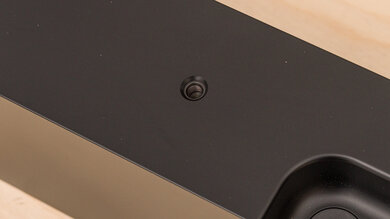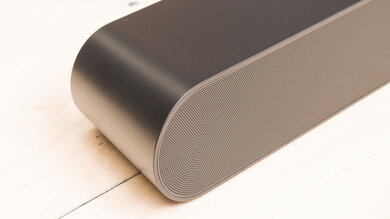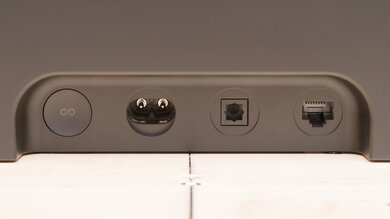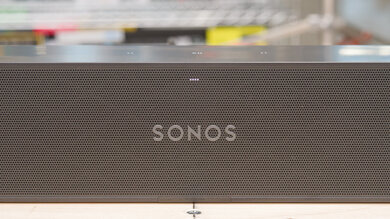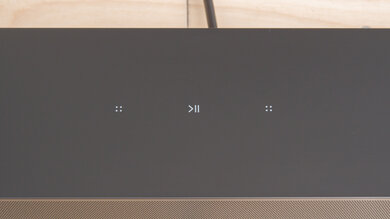The Sonos Ray is an affordable offering from the manufacturer released in 2022. This entry-level 2.0 soundbar is easy to integrate into your existing Sonos ecosystem using the Sonos S2 app. While it doesn't support Dolby Atmos content like the Sonos Beam (Gen 2) or the Sonos Arc, it can playback 5.1 surround sound content like Dolby Digital and DTS. You can upgrade the setup down the line with the Sonos Sub and speakers like the Sonos One SL or the Sonos Five.
Our Verdict
The Sonos Ray soundbar is acceptable for mixed usage. It's a simple bar that shines for vocal clarity, making it a solid choice if you want an upgrade over your TV speakers. As a standalone bar, it fails to provide the rumble in the bass range that brings action-packed scenes to life, but if you're mostly listening to vocal-centric content, you won't notice it. Naturally, it doesn't have as many features as Sonos' more premium offerings—there's no Dolby Atmos support, for example.
-
Clear and accurate vocal reproduction.
-
Room correction feature with iOS devices.
-
Dialogue enhancement mode.
-
Lacks low-bass.
-
No Dolby Atmos support.
-
No HDMI.
The Sonos Ray soundbar is decent for dialogue-heavy TV shows and podcasts. Its balanced, neutral mids mean that voices reproduce clearly and with detail, and there's a dialogue enhancement mode and a night mode feature to balance out the volume level when you watch TV at night. However, since it's a 2.0 setup, there isn't a discrete center channel to help provide a more clear and real representation of dialogue in the soundstage like you get with more premium models.
-
Clear and accurate vocal reproduction.
-
Dialogue enhancement mode.
-
No graphic EQ.
-
No Bluetooth support.
The Sonos Ray is fair for music. If you have a compatible iOS device, you can use its Trueplay room correction feature in the Sonos S2 app to optimize audio reproduction based on your room's unique acoustics. Its sound profile is pretty neutral, especially in the mids. You can adjust its sound, too, using its bass and treble adjustments. However, like most standalone bars, it doesn't provide the deep thump and rumble in the low-bass you find in genres like hip-hop. You can add on a separate sub, but it's pricey.
-
Clear and accurate vocal reproduction.
-
Room correction feature with iOS devices.
-
Lacks low-bass.
-
No graphic EQ.
The Sonos Ray is disappointing for movies. There's no Dolby Atmos support, so you can't take advantage of the full immersive experience with certain movies on streaming platforms. It can handle 5.1 surround sound formats like Dolby Digital and DTS; however, it has to downmix it into stereo to play it. While you can add a subwoofer or rear speakers for better performance, these extras aren't cheap, and movie lovers will probably prefer a bar with the full setup included.
-
Clear and accurate vocal reproduction.
-
Room correction feature with iOS devices.
-
Lacks low-bass.
-
No Dolby Atmos support.
-
No HDMI.
- 6.3 Mixed Usage
- 7.0 Dialogue/TV Shows
- 6.7 Music
- 5.5 Movies
- Updated Jun 16, 2023: Rewrote the review text for clarity. No changes in test results.
- Updated Mar 30, 2023: Added a market comparison to the Samsung HW-S60B/S61B in the Height (Atmos) box.
- Updated Mar 20, 2023: Added cable lengths to In The Box.
- Updated Mar 16, 2023: Converted to Test Bench 1.1. With this update, we've added a Mounting test and added information aboutSubwoofer Output, Spotify Connect, and Microphone Mute.
- Updated Nov 15, 2022: Retested the bar's sound with firmware version 14.18.
- Updated Jun 22, 2022: Review published.
- Updated Jun 15, 2022: Early access published.
- Updated Jun 14, 2022: Our testers have started testing this product.
- Updated Jun 08, 2022: The product has arrived in our lab, and our testers will start evaluating it soon.
- Updated May 15, 2022: We've purchased the product and are waiting for it to arrive in our lab.
Differences Between Sizes And Variants
This soundbar comes in two color variants: 'Black' and 'White'. We tested the 'Black' variant, and you'll find the label for our model here. We expect that the 'White' variant will offer similar performance.
If you encounter another version of this soundbar, let us know in the discussions, and we'll update our review.
Compared To Other Soundbars
The Sonos Ray is the manufacturer's budget-friendly soundbar. It's for those who want to get in on the brand with a simple, plug-and-play upgrade over their TV speakers, much like the Bose TV Speaker. It's a solid pick if you're already a fan of the Sonos ecosystem, and its pleasant vocal clarity makes it a fair choice for music and dialogue-focused TV shows. You can find better offerings for movies with a dedicated subwoofer and even rear satellites included for the same price as the Sonos bar—but fans of the Ray will likely appreciate its small, compact design in the first place.
See our recommendations for the best small soundbars, the best budget soundbars, and the best soundbars under $300.
The Sonos Beam is better than the Sonos Ray. The Beam is a 3.0 setup, meaning it has a discrete center channel to improve dialogue reproduction, unlike the Ray. It can reproduce a bit more rumble in the bass range, and its soundstage offers a much wider, more immersive listening experience. There's also an HDMI input, which the Ray lacks.
Depending on your listening habits, you may prefer the Bose TV Speaker or the Sonos Ray. They're both budget-friendly 2.0 setups that are best with music and dialogue-focused TV shows. However, the Bose can reproduce a more extended low-bass, making you feel more rumble in the mix. Unlike the Sonos, it supports HDMI connectivity, too. However, the Sonos comes with more sound enhancement features, such as room correction, and it lets you connect to the Sonos ecosystem through its Sonos S2 app. There's even DTS support, which the Bose lacks.
The Sonos Arc is a better standalone soundbar than the Sonos Ray. The Arc is a 5.0.2 setup that supports Atmos content, unlike the Ray. It has better soundstage, center, and surround performances and offers HDMI connectivity. The Ray offers a better value for listeners who want a simple setup for music and TV shows.
The Sonos Beam (Gen 2) is better than the Sonos Ray. The Beam is a 5.0 setup with better soundstage and surround performances, and unlike the Ray, it has Dolby Atmos support. It has a more extended low-bass, so you feel more rumble in the mix. There's HDMI connectivity and built-in voice assistant support, which the Ray lacks. However, the Ray is a more affordable option, and it's still a pretty decent choice for vocal-centric TV shows and music.
The Samsung HW-S60B/S61B and the Sonos Ray are both small standalone soundbars with premium designs. However, the Samsung soundbar is the more versatile soundbar overall. Since it supports Dolby Atmos content, you can take advantage of more immersive audio formats often found on streaming platforms. Its discrete center improves its vocal reproduction, and it has a better surround sound than the 2.0 Sonos.
The Bose Smart Soundbar 300 is a bit better than the Sonos Ray for most uses. The Bose is a 3.0 soundbar, so unlike the 2.0 Sonos, it has a discrete center channel to improve dialogue clarity. It reproduces more low-bass, too, and has HDMI connectivity. However, it doesn't offer as many sound enhancement features as the Sonos.
The Samsung HW-S60A is better than the Sonos Ray. The Samsung is a 5.0 bar with additional channels, including a center channel to improve dialogue reproduction as well as two side-firing drivers for surround sound. It has better soundstage and surround performances and reproduces more rumble in the bass range. There's no room correction like the Sonos, but the graphic EQ gives you lots of control over its sound.
Test Results
You can add a separate subwoofer from the manufacturer if you want to upgrade your setup.
The manufacturer sells a wide array of additional speakers to add on as rear satellites.
The Sonos Ray is smaller than the manufacturer's other offerings like the Sonos Beam (Gen 2), and its compact design easily fits between the legs of a 55" TV. Since it isn't very tall, it doesn't block your screen.
You can mount this bar to your wall, though the brackets aren't included, so you'll have to buy them from Sonos separately. The wall-mount hole is on the back of the bar, and you can see it here.
This bar has a good build quality. Its plastic build is solid overall, and the grille in the front helps to protect the drivers inside. That said, the material feels a bit cheaper compared to more premium offerings from Sonos, like the Sonos Beam (Gen 2).
The Sonos Ray has a fair stereo frequency response. Like most premium bars on the market, this soundbar comes with a room correction device that's designed to adjust its output based on your room's unique acoustics. It's called Trueplay, and it's available on compatible iOS devices. With it on, the bar's sound profile is pretty balanced, especially in the mids, where most voices and lead instruments reproduce. As with most standalone bars, the lack of bass is noticeable, especially with bass-heavy genres like hip-hop and EDM. Still, if you mostly listen to dialogue-centric TV shows without a lot of bass mixed in, you'll find the vocals pleasant and detailed.
The bar offers bass and treble adjustments to help you customize its sound more to your liking. However, if you prefer a more neutral sound, its default settings fall within the desired range, so you don't have to worry about playing around with its sound settings.
The bar's stereo soundstage is just okay, which is disappointing given the impressive performance of the manufacturer's top-of-the-line products. The soundstage is perceived to be a touch wider than the bar itself—but the bar isn't very wide to begin with, so it doesn't feel like sound stretches out towards the walls of your living room. That said, the focus is good, so sound effects, like instruments in an orchestra, seem to come from accurate, pinpoint locations in the soundstage.
The bar gets loud enough to fill an average-sized living room with sound. However, like most small bars, it doesn't get much louder than that, so it's unsuitable for listening in large, open spaces. There's also a bit of compression when you push it to max volume, especially in the bass range, so you notice pumping artifacts that distort the sound a bit.
The Sonos Ray has a good stereo total harmonic distortion performance. Distortion falls within good limits at normal listening volumes, so audio reproduction is clean and pure. While there's a slight increase in distortion at max volume in the mid-range, it's hard to hear with real-life content, especially if you're a more casual listener.
This soundbar is a 2.0 setup, so it doesn't have a discrete center channel. Instead, it simulates a phantom center using its left and right stereo drivers. Unfortunately, this sounds more diffused than a discrete center, and voices aren't as accurately placed in the soundstage. Still, the frequency response is quite balanced in the mids, where most voices reproduce, so dialogue is clear and accurate.
The Sonos Ray can playback 5.1 surround sound content like Dolby Digital and DTS, which are commonly found on streaming services and Blu-ray discs. However, the bar has to downmix this content into stereo to play it. The resulting sound isn't very immersive, and audio seems to be coming from speakers in front of you. Sound effects don't seem to come from all around you, either. However, you can always add rear speakers if you want a more clear and real representation of surround content.
You can always check out the Samsung HW-S60B/S61B if you want a small standalone bar with Atmos support.
Despite its more affordable pricing, this setup offers the same sound enhancement features as the more premium Sonos Beam (Gen 2). For example, iOS users can access the Trueplay room correction feature, which optimizes audio reproduction based on your space's unique acoustics. If you have an Android or want a different sound, there are bass and treble adjustments on hand for manual customization, too. There's a dialogue enhancement mode called Speech Enhancement and a Night Sound feature that balances the volume level between the loudest and quietest sounds when you watch at night. As with other Sonos soundbars, however, you won't find a full graphic EQ for a greater ability to customize its sound across the range.
The Sonos Ray has a limited selection of physical inputs. You can connect it to your TV using the Optical cable, but there's no HDMI support. You'll also find an Ethernet cable and a button to link any subwoofers and satellites you choose to add in the future.
This soundbar supports Dolby Digital content, the most common surround sound format used on streaming platforms and Blu-rays. Thanks to a recent update to the Sonos S2 app, there's also DTS support. However, the bar has to downmix this content into stereo to play it.
This soundbar has a great latency performance. Its low latency means that you don't notice a delay between the audio you hear and the video you see, and there aren't any lip-synching issues. Some apps and TVs compensate for latency differently, though.
The Sonos Ray has the same wireless playback offerings as other Sonos bars. You can wirelessly stream content to the bar over Wi-Fi and Apple AirPlay 2, and there's also support for Spotify Connect and Tidal Connect.
This soundbar doesn't come with a remote; you're meant to control it through the Sonos S2 app on your phone. If you own Sonos products, you're likely already familiar with the app's capabilities, as it lets you control a whole network of Sonos speakers simultaneously.
This soundbar doesn't have built-in voice assistant capabilities. However, you can pair the bar to a third-party Amazon Alexa or Google Assistant device to control it with your voice. You can set it up in the Sonos S2 app.




